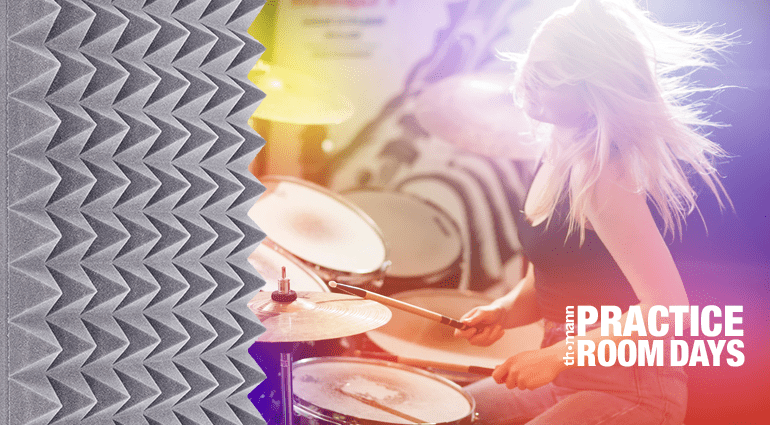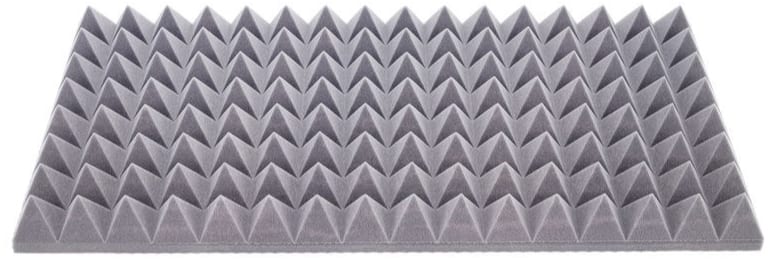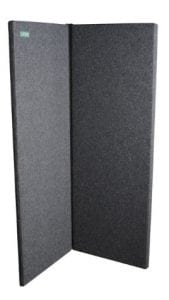
If you have ever made music in a rehearsal room, you know the problem: There is a rather indefinable “sound porridge”, which inevitably occurs and causes everyone to turn their instrument up (and up again…). With a strategic setup of the room and the with the right tools you can get many problems under control, but often you have to optimise the room acoustically yourself because each room is unique.
Absorb it
There are many products that can help you make the right improvements quickly. Mostly you work with “absorption“. “Absorbers” are a kind of “sound sponge” that prevents sound from being reflected back from a hard surface. One of the simplest absorbers is a pyramid foam that every musician has probably seen before:
A typical basement room or an empty classroom at school, which is to be converted into a rehearsal room, is often too acoustically reflective, which can make drums sound too sharp, vocals sound hollow and tinny, and the definition of instruments is lost. In such an environment it can be impossible for you to work out subtleties with the band, even to groove properly on your own.
The remedy in this case is to dampen the bare walls a bit. The means of choice is absorption, which dampens the high and high-mid frequencies. It is important to avoid large, bare surfaces with parallel walls. Usually it is a good idea to install some absorbers, evenly distributed, on two adjacent walls. In small rooms, even just two panels, one square metre each, can work wonders!
- Just one configuration
Absorbers can be quite elegant:
Your rehearsal room should not sound too “dead“, you should allow for some reverberation and reflection. Otherwise you will have the feeling of playing in a closet.
What’s a production without curtains?
Windows and other hard reflecting surfaces can be defused if necessary with a curtain made of molton, a thick and opaque coton. Some of these can also help to keep the cold out of your room during those winter months. Of course, makes sure to get the right size and colour for your needs…
- Stairville Curtain in black
- and many other colours
As Above, So Below
Two huge areas are often overlooked: Floor and ceiling! While the floor is quite problem-free due to instruments, amplifiers and furniture, the ceiling often remains bare. It can, and often should, be fitted with acoustic panels as well.
For more absorption (and warmth) on the floor, why not throw down a rug or two?
- Thomann Drum Rug
- Meinl MDR-ZB Zebra Drum Rug
Trap that bass!
It can often be more difficult to control the lower mids and lows. There are bass traps to tame the low frequencies. They are particularly effective when they are placed in the corners of a room. Physics is sometimes unfair: Bass traps only work if they are quite large, so taming the bass is more complicated, takes up more space and costs more.
A popular and very functional bass trap is the following from Hofa:
…but a lot can be achieved with suitable foam in the wall corners:
- the t.akustik CBT-37
Don’t forget diffusion
The aim of acoustic treatment is not only to make as much sound “disappear” as possible. To achieve this you need to also use diffusors along with absorbers. What they do is distribute incoming sound evenly in different directions. This prevents hard, disturbing reflections (such as “flutter echoes“) on the one hand, but at the same time does not make the room “dead”. In addition, some diffusors look quite interesting and decorative:
- Hofa Diffusor natur
So there’s another topic to discuss: aesthetics. There are some really beautiful acoustic panels which can give a professional studio look to your grimy or plain rehearsal room. And keep your eyes open for complete acoustic treatment packages:
- Auralex Acoustics Roominators Alpha-DST Burgundy
- the t.akustik Room Set 1
Gotta keep ’em separated
Depending on the setup in your rehearsal room, it may also be useful to acoustically separate individual instruments from each other. There are transparent dividing panel through which you can still see each other (which also reflect strongly), but also separators that absorb at the same time:
- Clearsonic A5-5 Drum Panel
- Clearsonic S2466
- Vicoustic Flexi Wall 3 Set
- Hofa Acoustic Curtain Iso Standard
Knock, knock, it’s the neighbour
One more thing you have to consider: Sound insulation of the room. If there are problems with “noise” that makes someone outside the rehearsal room feel disturbed (or furious!) other solutions have to be found. Sometimes, however, decoupling products like the Noise Elimination Podium provide significant isolation – or the switch to in-ear monitoring during the rehearsal.
- Thomann Drum Noise Elimination Podium
- Shure SE535-CL
- InEar StageDiver SD-2
We truly hope that these products and techniques help you to perfect the acoustics in your musical & magical space. Don’t forget to share it with your band mates and friends.
Do you have any experience with acoustic treatment? Did we miss something important? ? Please let us know in the comments ? and share your knowledge with the music community! We would all appreciate it 🙂
You are currently viewing a placeholder content from Facebook. To access the actual content, click the button below. Please note that doing so will share data with third-party providers.
More InformationYou are currently viewing a placeholder content from Instagram. To access the actual content, click the button below. Please note that doing so will share data with third-party providers.
More InformationYou are currently viewing a placeholder content from X. To access the actual content, click the button below. Please note that doing so will share data with third-party providers.
More Information




























